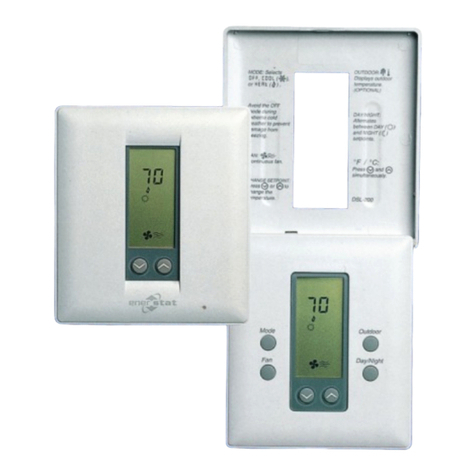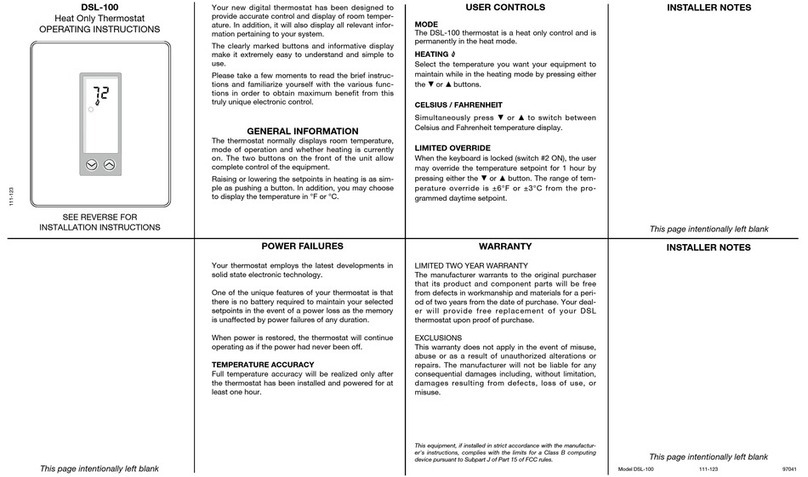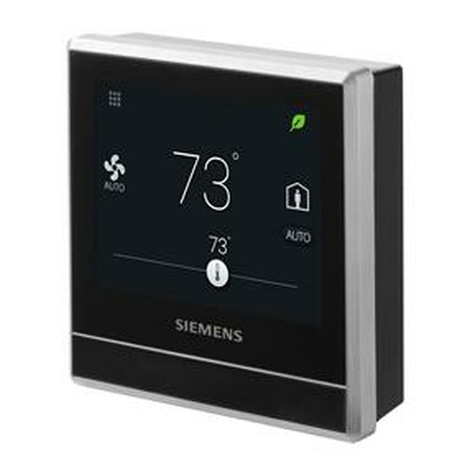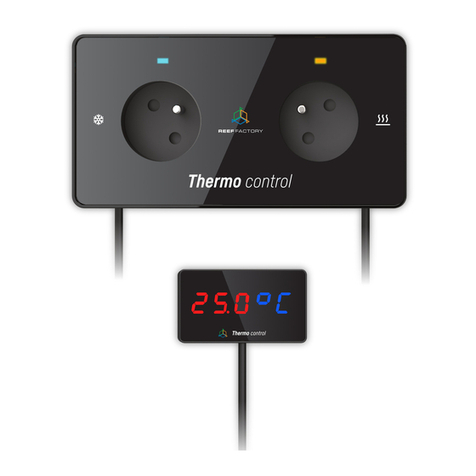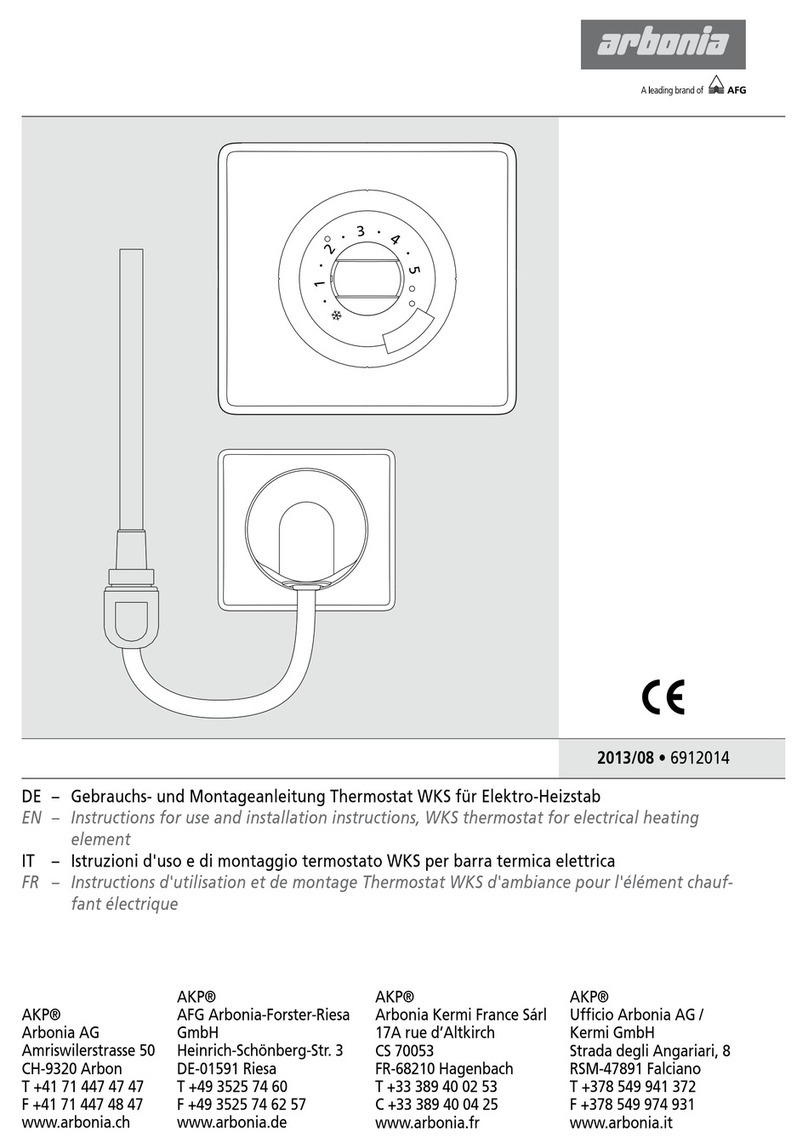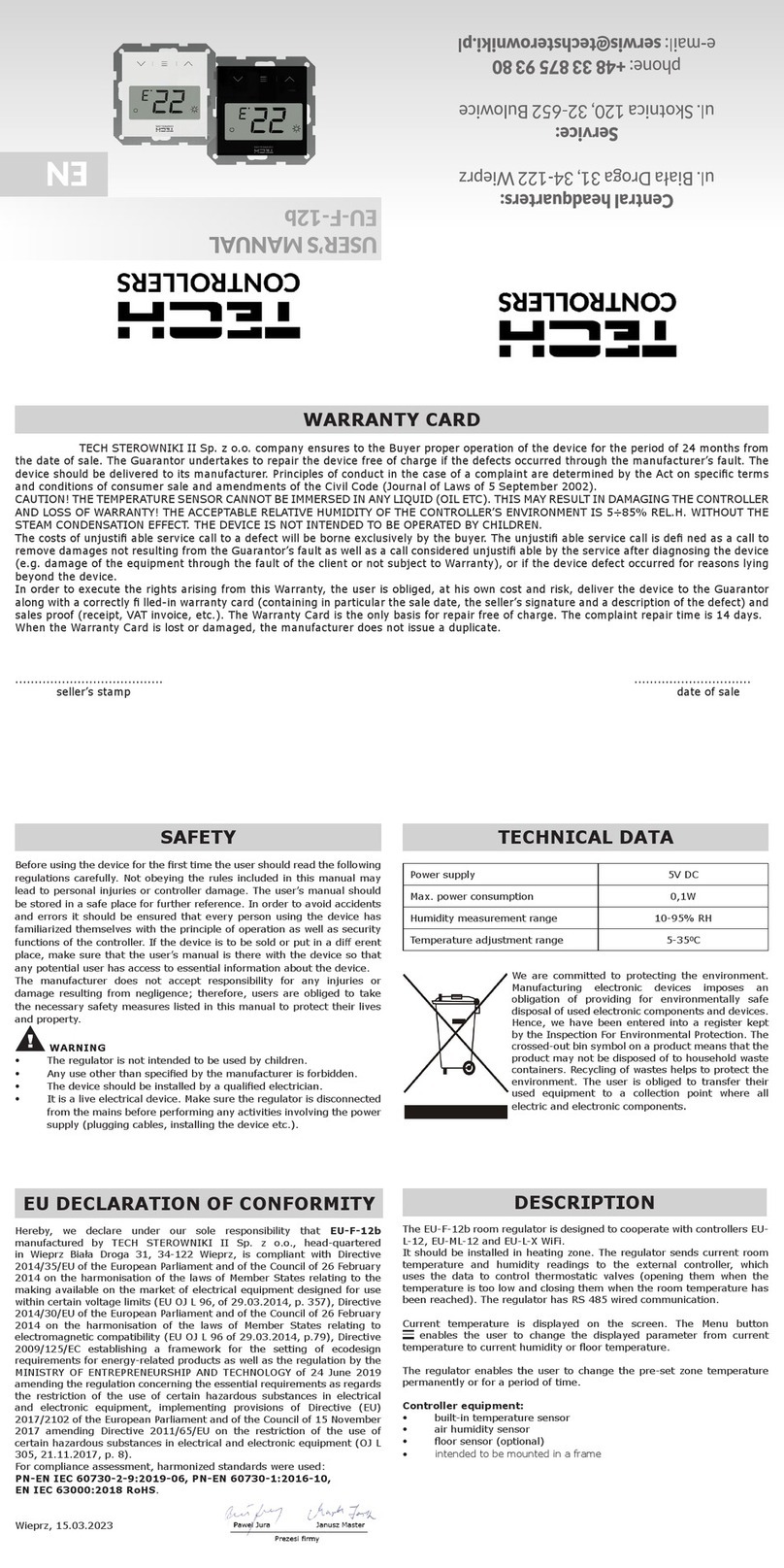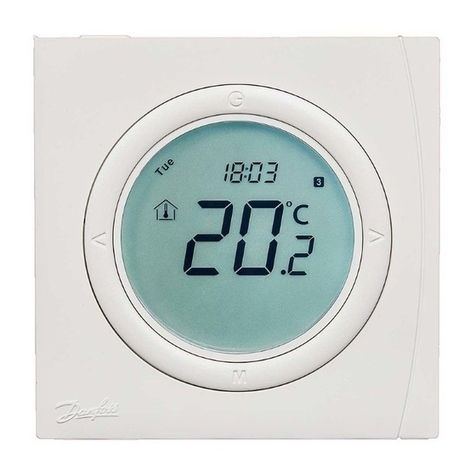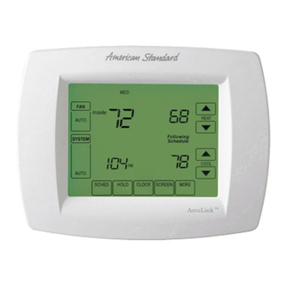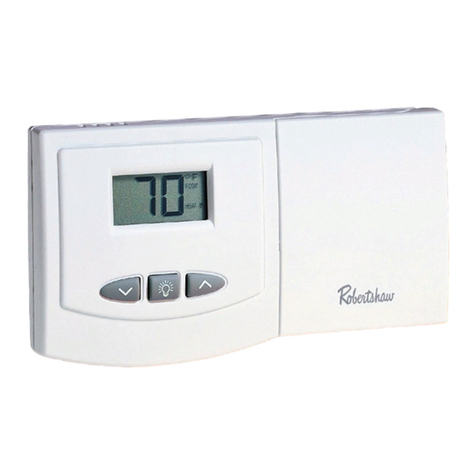enerstat SC1 User manual

The Button Functions
Clock Press to set current day, hour and minute
DST Press to change from Standard Time to Daylight Saving Time
Program Press to set program days, start times and cooling setpoints
Hold Press to hold the current setting. The program will hold
indefinitely or until RESUME is pressed.
Outdoor Press to display the outdoor temperature (optional)
Mode Press to select cool or off
Fan Press for continuous fan or auto fan
Resume Press to exit the hold or override program or when
programming is complete
✞✟ Press down or up buttons during programming and overrides
to lower or raise setpoints and change the day and time
(Temperature display in Fahrenheit or Celsius is a selectable option)
Understanding 5-2 Day Programming
It is recommended that you read and understand these instructions
before you attempt to program your new thermostat.
Events and Temperatures (Setpoints)
Programming a 5-2 day thermostat is easy once you understand how it
works. The 5 refers to the 5 weekday period, Monday through Friday. The 2
refers to the 2 weekend days, Saturday and Sunday. The weekday period is
divided into 4 events. An event is a designated period of time during the
day. The events are called Morning, Day, Evening and Night. Thus, the
weekdays are divided into Morning, Day, Evening and Night or 4 events.
The same holds true for the weekend days. Each of the 4 events is pro-
grammed for a cooling temperature.To exit programming at any time press
and release the RESUME button, or 15 seconds after pressing the last but-
ton the display will automatically change to the normal display.
Operating Instructions
5-2 Day Programmable Thermostat
Cool Only Programmable Thermostat
Programming the Thermostat
Setting the Current Day and Time
1. Press and release the CLOCK button. The display will flash MO
for Monday.
2. Press the ✞or ✟button until the current day appears on the dis-
play.
3. Press the CLOCK button to set the hour. The display will flash 12: .
4. Press the ✞or ✟button until the current hour appears on the
display. Be sure the AM or PM corresponds to the proper time.
5. Press the CLOCK button once again to set the minutes. The dis-
play will flash :00 .
6. Press the ✞or ✟button until the current minutes appear on the
display.
You have now set the current day and time on the thermostat and
are ready to begin programming the details of the events and set-
points.
Adjusting the Clock for Daylight Saving Time
To adjust the clock for Daylight Saving Time, simply press and
release the DST button on your thermostat. This will cause the hour
to advance by 1 and the DST icon will be displayed. Pressing and
releasing the DST button again will cause the clock to fall back 1
hour and remove the DST icon.
Selecting Fahrenheit or Celsius Display
Simultaneously press the ✞and ✟buttons to switch between
Fahrenheit and Celsius.
Changing the Clock from 12 to 24 Hour
To change the time indicated from 12 hour to 24 hour, press and
release the CLOCK button, then press the MODE button.
Program the Weekday/Weekend Event Start Times
and Cooling Setpoints
1. Press the PROGRAM button.
On the display you will see
MO TU WE TH FR, representing the weekdays,
a Morning ✣icon, a flashing starting hour,
and cooling setpoint.
2. Select the desired starting time hour by pressing the ✞or ✟
button. Be sure the AM or PM corresponds to the proper time.
3. Press and release the PROGRAM button to select the minutes.
4. Select the desired minute (if necessary) by pressing
the ✞or ✟button (in increments of 10 minutes).
5. Press and release the PROGRAM button; the cooling setpoint
will flash.
6. Select the desired cooling setpoint by pressing the ✞or ✟button.
7. Press and release the PROGRAM button.
8. Continue until all the desired event start times and cooling set-
points have been programmed.
You may only require the Morning and Night programs. In this
case you may skip the Day and Evening event; refer to “Skipping
An Event.”
9. Once you have set all of the weekday event start times and cool-
ing setpoints, press the PROGRAM button to move to the week-
end events and SA SU will be displayed.
10. To program the weekend events simply repeat the steps used to
program the weekday events.
To exit programming at any time press and release the RESUME
button, or 15 seconds after pressing the last button the display
will automatically change to the normal display.
Skipping an Event (2 Methods)
Your personal schedule may not require the use of all 4 events on a partic-
ular day. For example, if you wish to go from the Day event directly to the
Night event and skip over the Evening event, there are 2 methods you can
apply:
A. - Press and release the PROGRAM button until you come to the week-
day or weekend event hour that you wish to skip.
- Press and hold down the PROGRAM button and at the same time
press and release the MODE button. In the time display area you will
see _ _ : _ _ indicating that the event is skipped.
B. If any two or more events have the same start time, the latest event
in the day has priority and therefore uses its setpoints.
Reviewing Scheduled Times and Setpoints
You may wish to review the program schedule. You may do this by repeat-
edly pressing and releasing the PROGRAM button. Each of the scheduled
events will be displayed starting with the weekday start times and tempera-
tures. To cancel your review, simply press and release the RESUME button,
or wait 15 seconds for the thermostat to resume the display automatically.
Viewing the Outdoor Temperature (Option)
If your thermostat has been installed with an electronic outdoor remote
sensor, you may view the outdoor temperature simply by pressing the
OUTDOOR button. Upon releasing the button, the thermostat will once
again display the indoor temperature.
Temporary Temperature Override
You may wish on occasion to temporarily change the scheduled setpoint
during an event. You may do this at any time without affecting the pro-
gram. Simply press the ✞or ✟buttons to lower or raise the setpoints. The
new setpoint will be retained for 3 hours and will not affect the program-
ming schedule. You may return to the regular program schedule by press-
ing the RESUME button.
Temporary Temperature Override with Keypad Locked
(The keypad may be locked to prevent tampering by selecting the ON posi-
tion of DIP switch #2.)
If the keypad is locked to prevent tampering you may still temporarily
adjust the setpoint by
±3°C or ±6°F of the programmed Morning (4 event) or
Day (2 event) setpoint without affecting the program. Press the
✞or ✟but-
ton to raise or lower the setpoint for a 1 hour period. This override may not
be cancelled by pressing the RESUME button.
Constant Override
To maintain a temperature setting for an indefinite period of time, press
and release the HOLD button. The word HOLD will appear on the LCD. The
current scheduled setpoint will be maintained. To select a different set-
point, press the ✞or ✟button to raise or lower it. The last setpoint select-
ed (scheduled or new) will be maintained continuously until the RESUME
button is pressed.
Off Mode
To turn off the cooling system, press the MODE button until the word OFF
appears on the LCD. It will remain displayed until the mode is changed.
The OFF mode prevents the system from being energized.
For example, you may begin by programming the weekday Morning event
setpoint to cool to 70˚F. As a result, every weekday Morning event will cool
to 70˚F. Next select the Day event and cooling setpoint. Continue until you
have programmed all 4 events in the same fashion. The setpoints that you
have selected to represent your events will be consistent for the 5 week-
days, Monday through Friday. You will go through the same procedure to
set the weekend (Saturday and Sunday) events. If you change a setpoint
in any of the weekday or weekend events, it will change the corre-
sponding setpoint for that particular event in either the weekday or
weekend programs, whichever period the event occurs in.
Event Times
You are required only to set a starting time for each event. An event ends
at the same time that the next event begins. For example, you may choose
to have the Morning event begin at 6:00 AM and the Day event set to begin
at 9:00 AM. The Morning event and the temperature will automatically
change to the Day event setpoint at 9:00 AM.
You must program the 4 events and their corresponding setpoints into your
thermostat for both the weekday and weekend periods.
Set Your Personal Schedule
This blank list is for your own use. Start by selecting your cool temperature setpoints.
Determine the times you want the temperatures to be active. Write in the desired
times in the appropriate location.
NOTE: It is suggested that you set your desired Morning program times about 1 hour
before the time that you actually require your home to reach the set temperature. If
you normally wake at 7 AM, set the wake up temperature to come on at 6 AM.
If you wish to skip a temperature, refer to “Skipping an Event.”
234
8
765
111-127

2 (Two) Year Limited Warranty
The manufacturer warrants to the original purchaser that its product and component parts will
be free from defects in workmanship and materials for a period of 2 (two) years from the date of
purchase. Return to the original point of purchase for replacement of your product.
Warranty Limitations
This warranty begins at date of purchase.
Warranty is Void if:
The date code is defaced or removed.
The product has a defect or damage due to product alteration, connection to an improper elec-
trical supply, shipping and handling, accident, fire, flood, lightning, or other conditions beyond
the control of the manufacturer.
The product is not installed according to the manufacturers instructions and specifications.
The product has been installed near sources of electromagnetic interference (EMI) such as arc-
ing relay contact.
Owner’s Responsibility
Provide proof of purchase
Provide normal care and maintenance.
Pay for freight, labor and travel.
Pay for service calls related to product installation.
Return any defective product.
In no event shall the manufacturer be liable for incidental or consequential damages.
This warranty gives you specific legal rights and you may have others which vary by state
and/or province. For example, some states and/or provinces do not allow the exclusion or limi-
tation of incidental or consequential damages so this exclusion may not apply to you.
The manufacturer’s continuing commitment to quality products may require a change in specifi-
cations without notice.
This equipment, if installed in strict accordance with the manufacturer's instructions, complies
with the limits for a Class B computing device pursuant to Subpart J of Part 15 of FCC rules.
Terminal Designations
RC . . . . . .24 VAC supply from cooling equipment transformer
Y . . . . . . . .Energizes cooling equipment with a call for cooling
G . . . . . . .Fan is energized with a call for cooling or by
pressing the FAN button.
RS2 . . . . .Use to connect up to 6 (SL-IDS) indoor and or 1 (SL-ODT)
RS1 outdoor remote sensor/s.
RS+V When connected the thermostat will automatically use the
the SL-IDS temperature sensor and not its own. Refer to
the instructions included with the sensor.
DIP Switch Options and Functions
Positioning the DIP switches in either the ON or OFF position enables
you to choose between two different options. The DIP switches are
located on the interior of your thermostat and may be accessed by
following the procedure for removing the thermostat from the sub-
base. The following list describes your DIP switch options.
Specifications
Rated Voltage . . . . . . . . . . . 20-30 VAC, 24 nominal
Rated A.C. . . . . . . . . . . . . . . 0.08 Amps to 1.5 Amps continuous
Current per output with surges to 4 Amps Max.
Control Range . . . . . . . . . . .Cooling: 60° to 108°F in 1° Steps
16° to 40°C in 1° Steps
Thermostat
Measurement Range . . . . .28° to 124°F or 0° to 48°C
O.D.T. Displayed
Range . . . . . . . . . . . . . . . . . .-50° to 119°F or -48° to 47°C
Control . . . . . . . . . . . . . . . . .± .5° C at 20°C
Accuracy ± 1°F at 68°F
NOTE: This thermostat contains electronic circuitry replacing the
conventional mechanical anticipator.
Model SC1 111-127 98192
DIP Switch No. DIP Switch OFF DIP Switch ON
1
2
4 minute minimum ON
Keypad unlock
2 minute minimum ON
Keypad lock
1. 2 Minute or 4 Minute On Times This option allows you to run the
equipment for either a 2 or 4 minute minimum off and on time.
2. Keypad Lock %In the ON position locks out all buttons except the
outdoor temperature button.
Installation Instructions
It is recommended that installation be performed by a qualified installer.
Location
To ensure proper operation, the thermostat should be mounted on an
inside wall in a frequently occupied area of the building. In addition, its
position must be at least 18" (46cm) from any outside wall, and approx-
imately 5' (1.5m) above the floor in a location with freely circulating air
of an average temperature. You should avoid the following locations:
- behind doors or in corners where freely circulating air is unavailable
- where direct sunlight or radiant heat from appliances might affect
control operation
- on an outside wall
- adjacent to, or in line with, conditioned air discharge grilles, stair-
wells, or outside doors
- where its operation may be affected by steam or water pipes or
warm air stacks in an adjacent partition space, or by an
unheated/uncooled area behind the thermostat
- where its operation will be affected by the supply air of an adjacent
unit
- near sources of electrical interference such as arcing relay contacts
Removing the Thermostat from the Subbase
1. Insert a flat blade screwdriver or a coin 1/8" into the slot located in the
bottom center of the thermostat case and twist 1/4 turn. When you feel
or hear a “click,” grasp the case from the bottom two corners and sepa-
rate from the subbase. Some models require more force than others
when separating due to the number of terminals used.
2. Swing the thermostat out from the bottom.
3. Lift the thermostat up and off the subbase.
4. Place the rectangular opening in the subbase over the equipment con-
trol wires protruding from the wall and, using the subbase as a tem-
plate, mark the location of the two mounting holes (exact vertical
mounting is necessary only for appearance).
5. Use the supplied anchors and screws for mounting on drywall or plaster;
drill 3/16" (5mm) diameter holes at the marked locations; use a hammer to
tap the nylon anchors in flush to the wall surface and fasten subbase using
the supplied screws. (Do not overtighten!)
6. Connect the wires from your system to the thermostat terminals as shown
in the wiring diagrams. Carefully dress the wires so that any excess is
pushed back into the wall cavity or junction box. Ensure that the wires are
flush to the plastic subbase. The access hole should be sealed or stuffed to
prevent drafts from the wall affecting the thermostat.
Replacing the Thermostat on the Subbase
1. Position the thermostat on the hinged tabs at the top of the subbase.
2. Gently swing the thermostat down and press on the bottom center edge
until it snaps in place.
Description Of Icons
Display icons vary according to the model. Your thermostat may not display
all of the icons shown.
Thermostat Cover Lock
If desired, insert the plastic lock
piece into the bottom of the mount-
ed base. The ends of the lock piece
should fit snugly under the lock pins
extending from the bottom of the
mounted base. The tab in the middle
of the lock piece should extend
downward from the mounted base.
To release the locking mechanism,
press the lock piece up and into the
base while gently prying open the
cover at the same time. Use caution
to avoid cracking the thermostat
base or cover.
Plastic
lock pin
Snap plastic
lock into
place
Wiring Diagram Installing The Resistor (Provided)
Programmable thermostats with solid state equipment outputs require a
minimum of 80 mA AC (0.08A) of current draw to ensure switching integrity.
1. The installer must be a qualified service technician.
2. Read the instructions carefully. Failure to do so may damage the product
or cause a hazardous condition.
3. Connect the resistor leads to the equipment terminal strip across the Y or
G (as required) and the 24VAC common terminals. Avoid contact with any
other terminals or components within the equipment. Connect either end
of the resistor to the terminals (non-polarized) and firmly tighten the screw
terminals.
Notice
The resistor will become warm during equipment operation. This is normal.
910 11 12
1615
14
13
Transformer Wiring Diagram
If the transformer
common terminal is
not available, con-
sult the equipment
manufacturer.
The thermostat will be held in the Night program until the
user resets the clock. The thermostat will display AC when the
24 VAC is not supplied. One of the unique features of your ther-
mostat is that there is no battery required to maintain your select-
ed setpoints in the event of a power loss, since the memory is
unaffected by power failures of any duration. There is no reason
to re-program the setpoint temperatures or start times since the
thermostat will retain these program parameters.
Power Outages & Power Failures During Regular Program Schedule
Should your power fail at any time during the regular program, the thermo-
stat will maintain the clock internally for up to 30 minutes. If the power has
not been restored during this time period, the clock will stop. When the
power is restored, the thermostat clock defaults to a flashing 12:00 AM.
Other enerstat Thermostat manuals
Popular Thermostat manuals by other brands
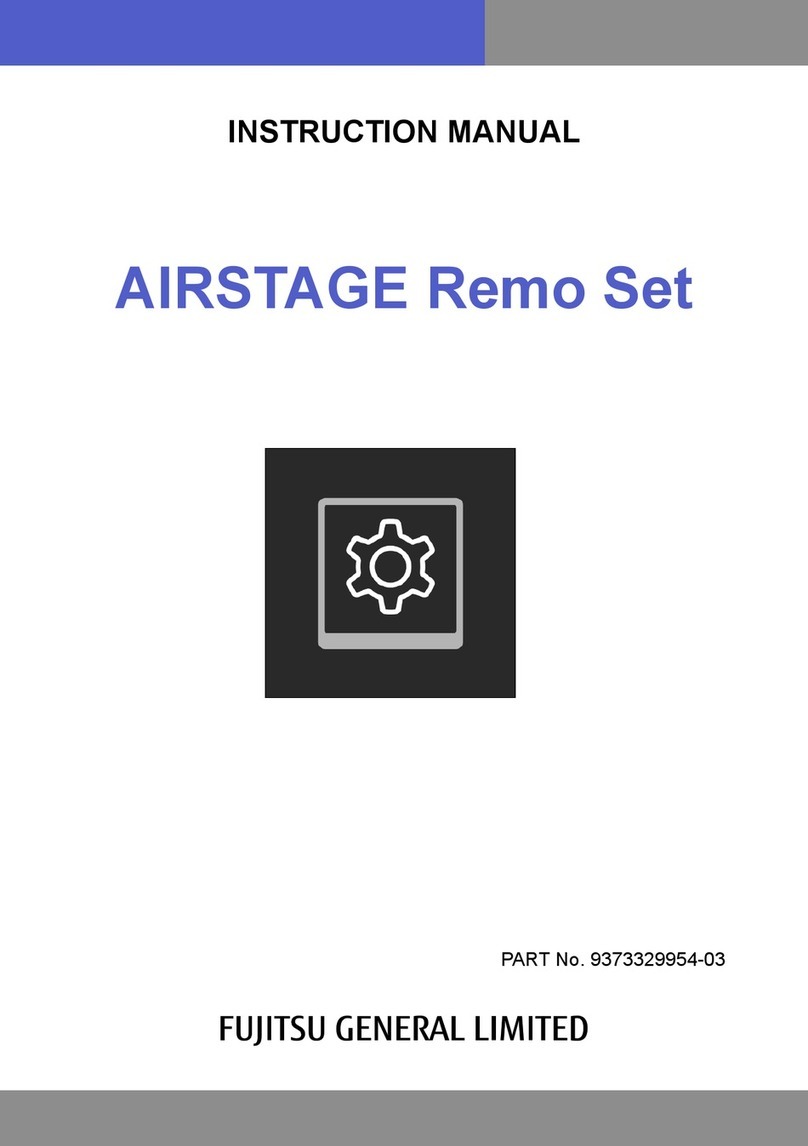
Fujitsu
Fujitsu AIRSTAGE Remo Set instruction manual
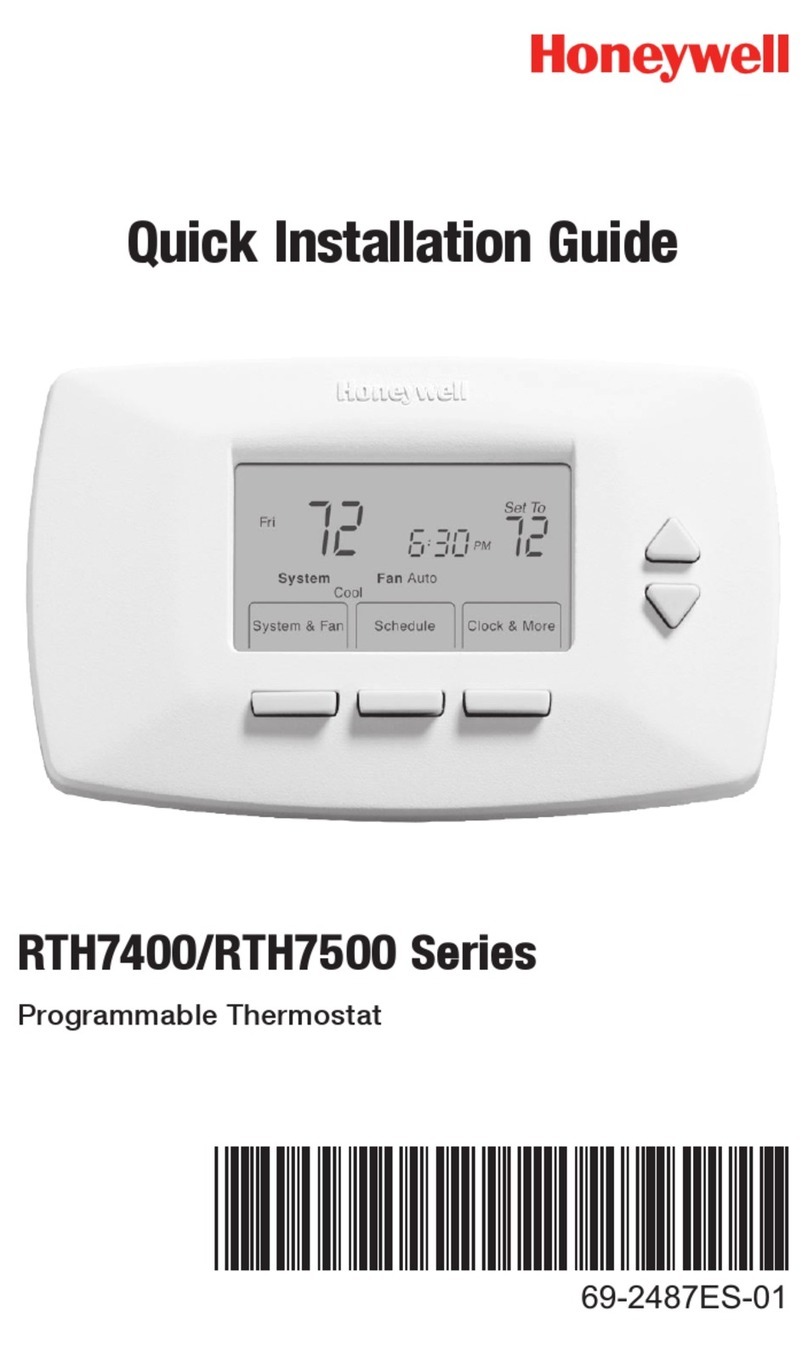
Honeywell
Honeywell YRTH7500D1009 - 5 Day Program Thermostat Quick installation guide
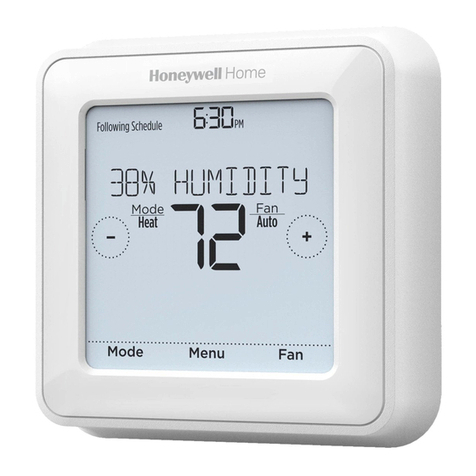
Honeywell Home
Honeywell Home T5 Smart Quick install guide
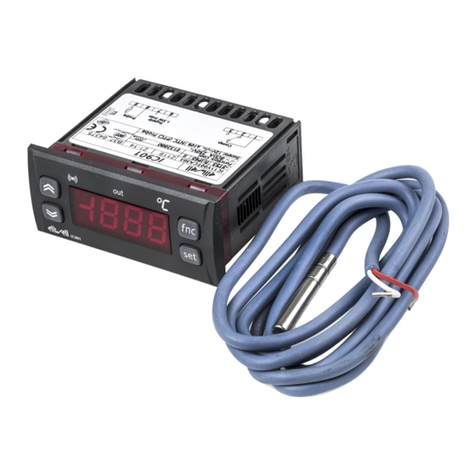
Eliwell
Eliwell IC 901 manual

Honeywell
Honeywell TH8110R1008/U user guide
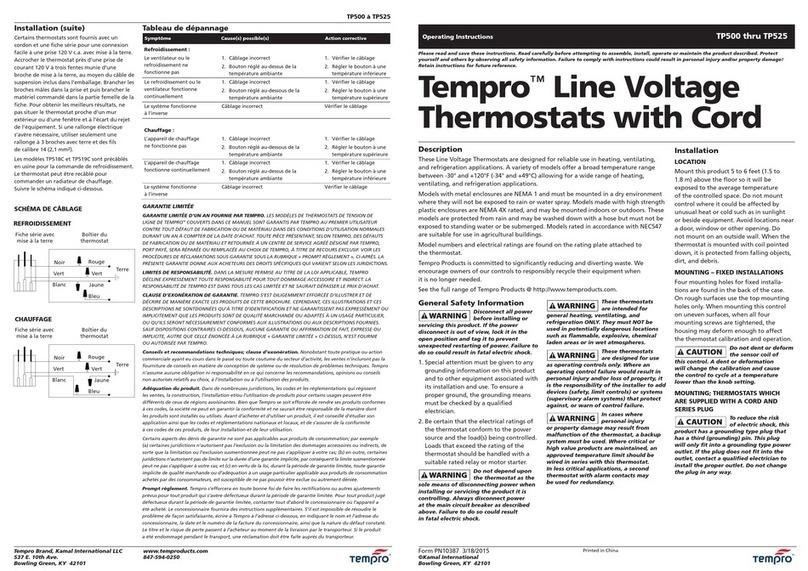
Tempro
Tempro TP500 operating instructions
